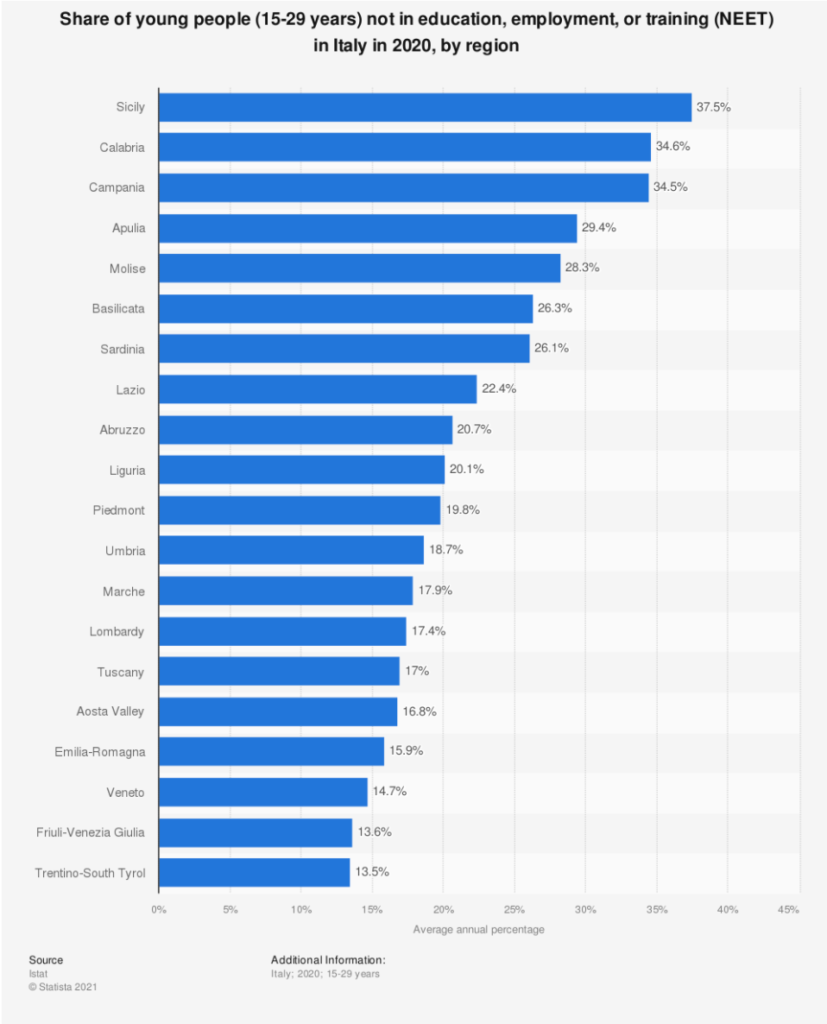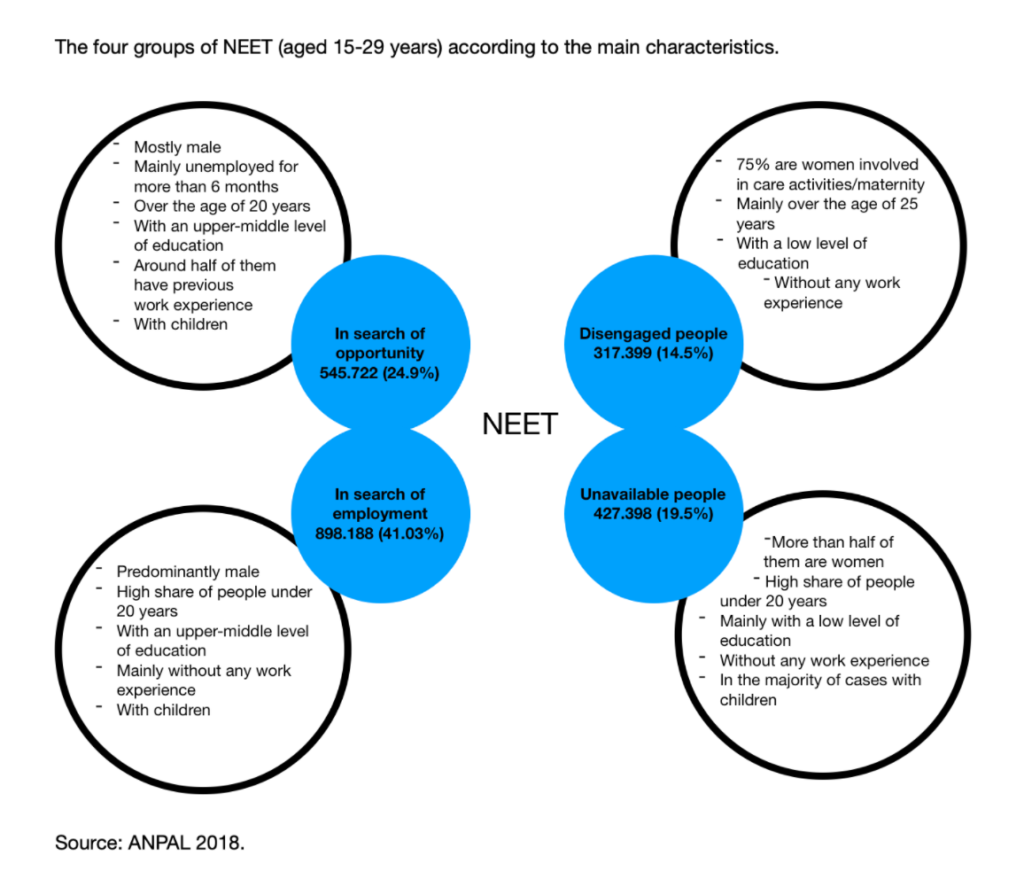
Written by Melissa Montasser
There is no country in the European Union that has such a high rate of NEET (i.e. not in Employment, Education, or Training) as Italy: in 2020, 25.1% of young Italians between 15 and 34 years fell into this category (Ellena et. al, 2021), compared to an EU average of 17.6% (Eurostat, 2021). This socio-economic phenomenon, however, is not a new one. In fact, in 2016 already, the then president of the European Central Bank Mario Draghi warned about a “lost generation” when talking about young people affected by this condition (Italian Ministry for Youth, 2021). Even though over the past five years a positive trend was being registered in Italy leading to a steady slight decrease of the share of NEET, their rate remained constant at over 20% (Statista, 2021). However, the outbreak of the pandemic has reversed this tendency again, resulting in a sharp increase in the number of NEETs in the whole of Europe (Eurostat, 2021) and Italy was not an exception from this general development (Statista, 2021). In the light of this worsening situation, the Italian government adopted on the 20th January 2022 a “NEET plan” that aims at reducing the more than 3 million young people between 15 and 34 years in the country that are presently neither working nor in education or training (Carli, 2022). The present policy brief seeks to point out the characteristics of the NEET in Italy and to evaluate afterward, also taking into account the elaborated specifics of the NEET, the set of measures introduced in order to deal with this phenomenon.
In 2020, 23.3% of young people between 15 and 29 years old fall into the vast group of NEET in Italy (Ansa, 2021), compared to the EU average of 13.7% (Eurofund, 2021). According to university professor and book author Alessandro Rosini, Italy’s particular exposure to this phenomenon is mainly explained by the inefficiencies in young people’s transition from school to work: in fact, especially in Italy, a vast number of recent graduates would enter their country’s labor market without having acquired the skills and work experiences required by the employers (La Rocca, 2017). Similarly, the economist Francesco Pastore attributes the circumstance that Italy is much more affected by NEET than other countries to the fact that the education offered is usually very broad and abstract whereas at the same time there is little to no professional training (Pastore, 2018).
This phenomenon is, however, characterized by a significant geographical divide: in fact, the share of NEET peaks in Southern Italy with Sicily registering the highest percentage of NEET individuals counting more than one out of three young people (37.5%) not in education, employment or training. The island is then closely followed in the ranking by Calabria (34.6%) and Campania (34.5%). By contrast, the North Italian regions Trentino-South Tyrol (13.5%), Friuli-Venezia Giulia (13.6%) and Veneto (14.7%) recorded the lowest rate (Statista, 2021).

At the same time, there is also a chasm between men and women. This is shown by the fact that with increasing age, a growing imbalance at the expense of women can be identified within the share of NEET in Italy: while women account for 45% of the NEET in the youngest age group (15 to 19 years), their share grows with advancing age up to 66% of the oldest age group (30-34 years) (Carli, 2022). This gender imbalance, in turn, indicates that the reasons for inactivity cannot only be traced back to the individuals’ socio-economic background but also to various other factors as well that have to be taken into account, as has been pointed out in a report by the National Agency for Active Labour Policies ANPAL. In fact, according to ANPAL, the Italian NEET can be divided into four different groups if their various motives for inactivity and their relations with the labor market are taken into account (ANPAL, 2018):
– Group 1 “in search of employment”: the largest group as 41.03% of the NEET fall into this category; it is composed of long-term and short-term unemployed that are mainly male and older than 20 years.
– Group 2 “in search of opportunities”: the second-largest group as it covers a share of 24.9% of the NEET. The individuals are mostly male and under 19 years old. They are all engaged in informal training activities or express their need to be trained.
– Group 3 “unavailable people”: the third-largest group (19.5%) is mainly composed of women older than 25 years. They are currently unavailable as they are dealing with family responsibilities and health issues.
– Group 4 “disengaged people”: this group comprises a share of 14.5% of the NEET and is composed of people of all ages, especially women, that are neither looking for a job nor for training activities and that are not affected by socio-familial obligations; instead, they are rather characterized by a pessimistic view of employment conditions and discouragement.

In order to deal with this phenomenon, the Italian government has now recently decided to adopt a “NEET plan”. However, the presented scheme shows that the Italian government is not planning anything new, but rather the extension and improvement of already existing means. These are in detail: a reinforcement of the Youth Guarantee, the establishment of youth desks at employment centers as well as an intensified informational support through the already existing campaign GIOVANI2030, and the launching of a multi-annual national plan that aims at promoting the inclusion of young people with fewer opportunities in the Erasmus+ and European Solidarity Corps programs (Italian Ministry for Youth, 2022).
Even though these points may be good approaches, various other aspects still should be added in order to reach the NEET. This need is shown, for instance, by a survey conducted among Italian NEET: 45% of the participants stated that they had never visited an employment center, whereas out of the 53% that had done so, a third (33,5%) specified that their visit had been at least three years ago (ANPAL, 2018). Therefore, it is absolutely necessary to invest in a large-scale promotional campaign in order to reach wider audiences. Furthermore, it is equally important to invest in childcare and care facilities as a vast amount of the NEETs ended up in that condition because of family responsibilities they have to deal with (cfr. group of “unavailable people”). Finally, also measures should be introduced in order to enable targeted education that also involves phases of practical training so that young people will face fewer struggles when entering the job market after having graduated.
All in all, it can be determined that the NEET in Italy is a phenomenon that is not only characterized by a regional disparity as the Southern part of the country is being much more affected, but also by clear gender inequality at the expense of women. Moreover, it is possible to divide the NEET into four different groups, according to their respective life circumstances. Recently, the Italian government has decided to adopt a “NEET plan” in order to reduce the great number of young people between 15 and 34 years that are neither working nor in education or training. Overall, this plan does not seek to introduce new measures, but rather to improve or enhance the existing ones. These approaches are good, but not sufficient to fully address the problem; rather, there are additional new measures needed such as promotional campaigns and greater support for young mothers.
References

 The ’Ndrangheta’s Infiltration and Threat to European Institutions
The ’Ndrangheta’s Infiltration and Threat to European Institutions  From Paper to Practice: How Grassroots Norms Undermine Gender Rights in Pakistan
From Paper to Practice: How Grassroots Norms Undermine Gender Rights in Pakistan  Exploited Childhoods: The Role of Global Corporations in Perpetuating and Mitigating Child Labour
Exploited Childhoods: The Role of Global Corporations in Perpetuating and Mitigating Child Labour  Human Rights Challenges in Addressing SLAPPs in Media, NGOs and Journalism in the EU
Human Rights Challenges in Addressing SLAPPs in Media, NGOs and Journalism in the EU 


